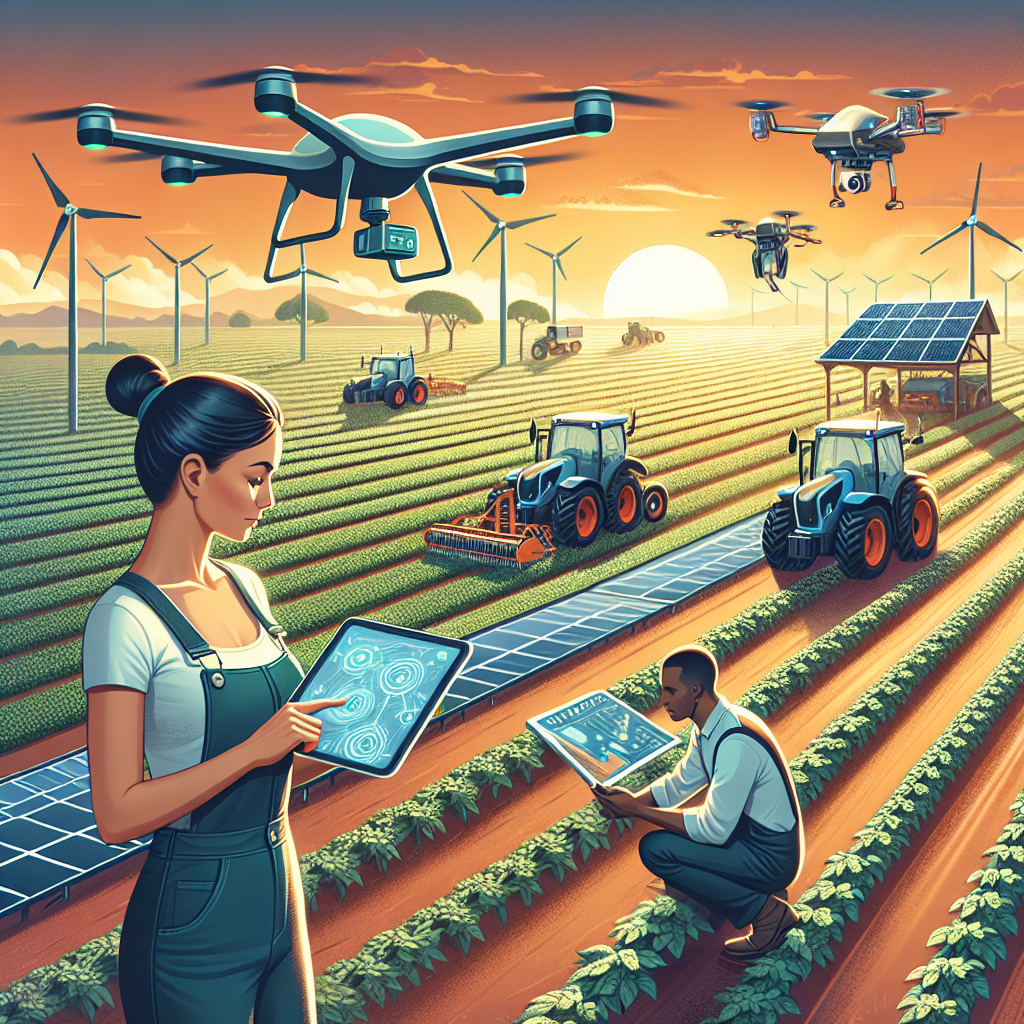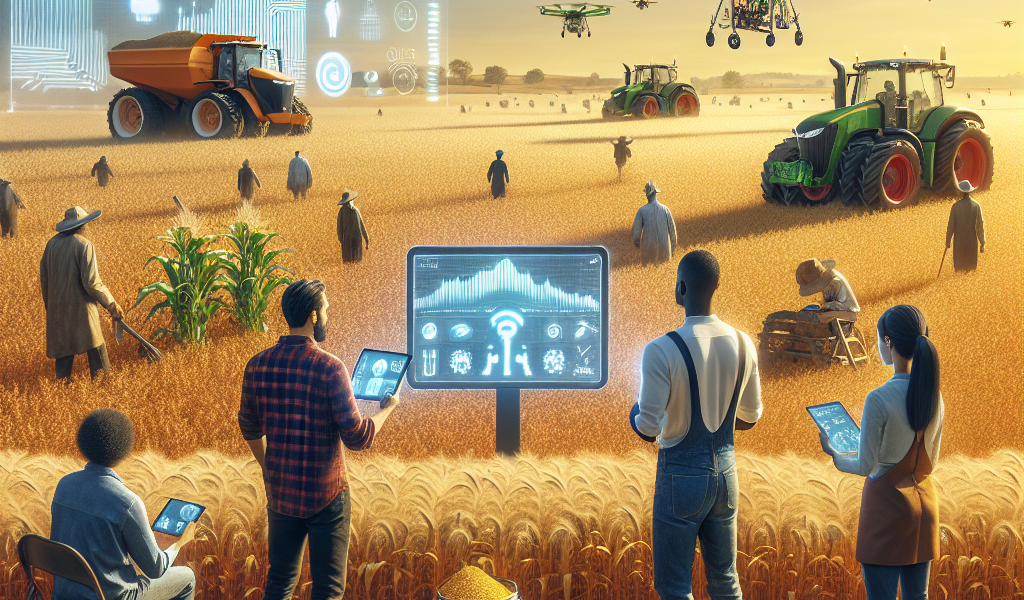-
Table of Contents
“Harvesting Innovation: Unlocking the Future with Smart Farming Techniques”
Introduction

Smart farming, also known as precision agriculture, leverages advanced technologies to enhance agricultural productivity, sustainability, and efficiency. By integrating tools such as IoT devices, drones, GPS mapping, and data analytics, smart farming techniques enable farmers to monitor crop health, optimize resource usage, and make data-driven decisions. This innovative approach not only maximizes yields and reduces environmental impact but also addresses challenges such as climate change, labor shortages, and food security. As the agricultural sector continues to evolve, exploring the benefits of smart farming techniques becomes crucial for fostering a resilient and sustainable future.
Enhancing Crop Yields with Precision Agriculture
In recent years, the agricultural sector has witnessed a technological revolution that promises to transform traditional farming practices. One of the most significant advancements in this domain is precision agriculture, a smart farming technique that leverages technology to enhance crop yields. By integrating data analytics, GPS, and IoT devices, precision agriculture offers farmers a more efficient and sustainable way to manage their crops.
To begin with, precision agriculture allows for more accurate monitoring of crop health. Traditional farming methods often rely on visual inspections and manual labor, which can be time-consuming and prone to human error. In contrast, smart farming techniques utilize sensors and drones to collect real-time data on soil conditions, moisture levels, and plant health. This data is then analyzed to provide farmers with actionable insights, enabling them to make informed decisions about irrigation, fertilization, and pest control. Consequently, this leads to healthier crops and higher yields.
Moreover, precision agriculture contributes to resource conservation, a critical aspect of sustainable farming. Water scarcity is a growing concern in many parts of the world, and traditional irrigation methods can be highly inefficient. Smart irrigation systems, guided by data from soil moisture sensors, ensure that water is applied precisely where and when it is needed. This not only conserves water but also prevents over-irrigation, which can lead to soil erosion and nutrient leaching. Similarly, precision agriculture techniques optimize the use of fertilizers and pesticides, reducing the environmental impact and lowering costs for farmers.
Another notable benefit of precision agriculture is its ability to enhance crop yields through site-specific management. Fields are rarely uniform; variations in soil type, topography, and microclimate can significantly affect crop performance. Precision farming tools, such as GPS-guided tractors and variable rate technology (VRT), allow farmers to tailor their practices to the specific needs of different field zones. For instance, VRT can adjust the amount of seed, fertilizer, or pesticide applied in each area, ensuring that resources are used efficiently and crops receive the optimal conditions for growth. This targeted approach not only boosts yields but also improves the overall quality of the produce.
Furthermore, the integration of big data and machine learning in precision agriculture opens up new possibilities for predictive analytics. By analyzing historical data and current conditions, these technologies can forecast potential issues such as pest outbreaks, disease spread, or adverse weather events. Early warnings enable farmers to take proactive measures, mitigating risks and minimizing crop losses. Additionally, predictive models can help farmers plan their planting and harvesting schedules more effectively, aligning their activities with market demands and maximizing profitability.
While the benefits of precision agriculture are clear, it is important to acknowledge the challenges that come with its adoption. The initial investment in technology can be substantial, and there is a learning curve associated with using new tools and interpreting data. However, as technology becomes more accessible and user-friendly, and as more farmers share their success stories, the adoption of smart farming techniques is expected to grow.
In conclusion, precision agriculture represents a significant leap forward in the quest to enhance crop yields and promote sustainable farming practices. By harnessing the power of technology, farmers can achieve greater efficiency, conserve valuable resources, and improve the quality and quantity of their produce. As the agricultural landscape continues to evolve, the adoption of smart farming techniques will undoubtedly play a crucial role in meeting the food demands of a growing global population.
Reducing Environmental Impact through Smart Irrigation Systems
Smart farming techniques have revolutionized the agricultural landscape, offering innovative solutions to age-old problems. Among these advancements, smart irrigation systems stand out as a pivotal development, significantly reducing the environmental impact of farming. By leveraging technology, these systems optimize water usage, ensuring that crops receive the precise amount of hydration they need, thereby conserving water and promoting sustainable farming practices.
One of the primary benefits of smart irrigation systems is their ability to monitor soil moisture levels in real-time. Traditional irrigation methods often rely on fixed schedules or manual assessments, which can lead to overwatering or underwatering. In contrast, smart irrigation systems use sensors placed in the soil to continuously measure moisture levels. These sensors communicate with a central control unit, which adjusts the irrigation schedule based on the data collected. This precise control not only conserves water but also ensures that crops are not stressed by inconsistent watering.
Moreover, smart irrigation systems can be integrated with weather forecasting services. By analyzing weather data, these systems can predict rainfall and adjust irrigation schedules accordingly. For instance, if a significant amount of rain is expected, the system can reduce or even skip irrigation cycles, preventing unnecessary water usage. This integration of weather data helps farmers make informed decisions, further enhancing water conservation efforts.
In addition to conserving water, smart irrigation systems also contribute to reducing the energy consumption associated with farming. Traditional irrigation methods often involve the use of pumps and other machinery that consume significant amounts of energy. By optimizing irrigation schedules and reducing the frequency of watering, smart systems can lower the energy demand, leading to a decrease in the overall carbon footprint of farming operations. This energy efficiency is particularly important in the context of climate change, as it helps mitigate the environmental impact of agricultural activities.
Furthermore, the adoption of smart irrigation systems can lead to improved crop yields and quality. Consistent and precise watering ensures that crops receive the optimal amount of water, which is crucial for their growth and development. Overwatering can lead to root diseases and nutrient leaching, while underwatering can stress plants and reduce their productivity. By maintaining the ideal moisture levels, smart irrigation systems promote healthier crops, resulting in higher yields and better quality produce. This, in turn, can enhance the profitability of farming operations, providing economic benefits alongside environmental ones.
Another significant advantage of smart irrigation systems is their potential to reduce the use of fertilizers and pesticides. When crops are watered efficiently, the risk of water runoff is minimized. Runoff can carry fertilizers and pesticides into nearby water bodies, causing pollution and harming aquatic ecosystems. By preventing runoff, smart irrigation systems help protect water quality and reduce the environmental impact of chemical inputs. This aspect of smart farming is particularly important for promoting sustainable agriculture and preserving natural resources for future generations.
In conclusion, smart irrigation systems offer a multitude of benefits that extend beyond mere water conservation. By optimizing water usage, integrating weather data, reducing energy consumption, and improving crop yields, these systems play a crucial role in promoting sustainable farming practices. Additionally, their ability to minimize runoff and protect water quality underscores their importance in reducing the environmental impact of agriculture. As the world grapples with the challenges of climate change and resource scarcity, the adoption of smart farming techniques, particularly smart irrigation systems, represents a promising step towards a more sustainable and resilient agricultural future.
Leveraging IoT for Real-Time Farm Monitoring and Management
In recent years, the agricultural sector has witnessed a technological revolution, with smart farming techniques taking center stage. Among these innovations, the Internet of Things (IoT) has emerged as a game-changer, offering real-time farm monitoring and management capabilities that were once the stuff of science fiction. By leveraging IoT, farmers can now optimize their operations, enhance productivity, and ensure sustainability, all while reducing costs and labor.
To begin with, IoT devices such as sensors, drones, and smart irrigation systems provide farmers with a wealth of data. These devices can monitor soil moisture levels, temperature, humidity, and even crop health. For instance, soil sensors can detect when a field is too dry and automatically trigger irrigation systems to water the crops. This not only conserves water but also ensures that plants receive the optimal amount of hydration, leading to healthier yields. Moreover, drones equipped with multispectral cameras can fly over fields to capture detailed images, allowing farmers to identify areas that need attention, such as pest infestations or nutrient deficiencies.
Transitioning from data collection to data analysis, IoT platforms play a crucial role in transforming raw data into actionable insights. Advanced analytics and machine learning algorithms can process the vast amounts of information gathered by IoT devices, providing farmers with real-time updates and recommendations. For example, predictive analytics can forecast weather patterns, helping farmers to plan their planting and harvesting schedules more effectively. Additionally, these platforms can offer insights into crop rotation strategies, pest control measures, and fertilizer application, all of which contribute to improved crop management and higher yields.
Furthermore, IoT technology enhances farm management by enabling remote monitoring and control. Farmers can access real-time data and manage their operations from anywhere using smartphones or computers. This level of connectivity is particularly beneficial for large-scale farms or those located in remote areas. For instance, a farmer can receive an alert about a malfunctioning irrigation system and address the issue immediately, preventing potential crop damage. Similarly, livestock farmers can monitor the health and well-being of their animals through wearable devices that track vital signs and movement patterns, ensuring timely interventions when necessary.
In addition to improving efficiency and productivity, IoT-driven smart farming techniques also promote sustainability. By optimizing resource usage, such as water and fertilizers, farmers can minimize their environmental footprint. Precision agriculture, which relies on IoT data, allows for targeted application of inputs, reducing waste and preventing overuse of chemicals that can harm the ecosystem. Moreover, IoT solutions can help in monitoring and maintaining soil health, ensuring that the land remains fertile and productive for future generations.
As we look to the future, the integration of IoT in agriculture holds immense potential for addressing global food security challenges. With the world’s population projected to reach nearly 10 billion by 2050, the demand for food will continue to rise. Smart farming techniques, powered by IoT, offer a viable solution to meet this demand by increasing agricultural productivity and efficiency. By embracing these technologies, farmers can produce more food with fewer resources, ensuring that we can feed a growing population without depleting our planet’s natural resources.
In conclusion, the adoption of IoT for real-time farm monitoring and management is revolutionizing the agricultural landscape. From data collection and analysis to remote control and sustainability, IoT technology offers a myriad of benefits that are transforming traditional farming practices. As farmers continue to embrace these innovations, the future of agriculture looks brighter, more efficient, and more sustainable than ever before.
Conclusion
In conclusion, exploring the benefits of smart farming techniques reveals significant potential for enhancing agricultural productivity, sustainability, and efficiency. By leveraging advanced technologies such as IoT, AI, and data analytics, farmers can optimize resource use, reduce environmental impact, and improve crop yields. These innovations not only address the growing global food demand but also contribute to more resilient and adaptive farming practices in the face of climate change. Overall, smart farming represents a transformative approach that can lead to a more sustainable and prosperous agricultural future.





